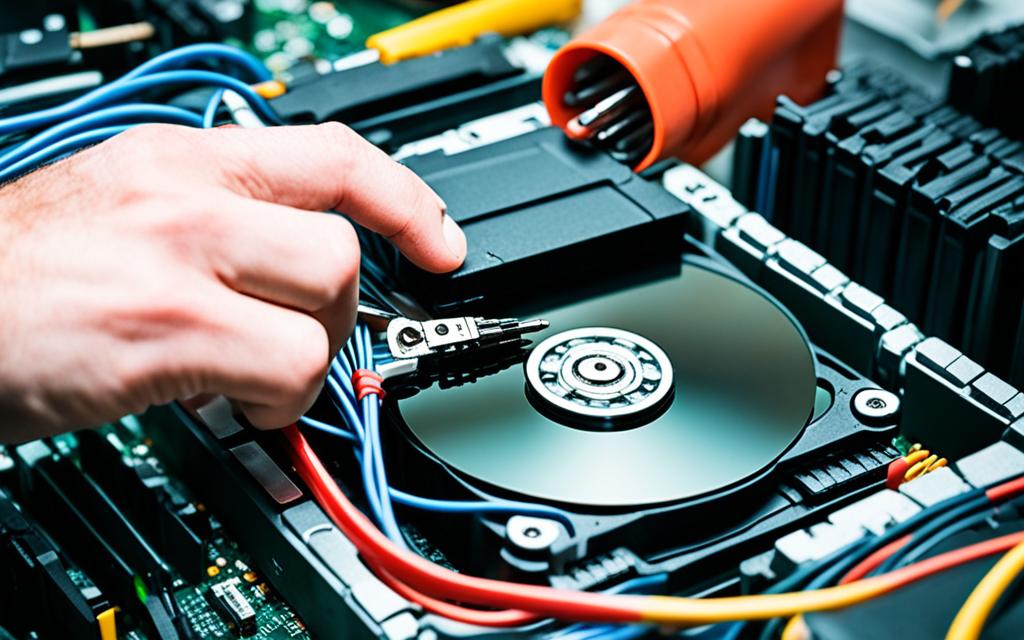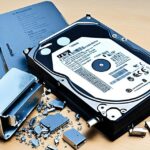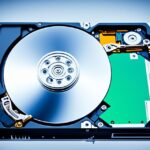Table of Contents
In the world of tech today, learning how to remove an OS from a hard drive is key. This might be because you need more space, want to manage multiple systems, or just clean up. It’s important to do this right to avoid losing data and to keep your hardware running smoothly.
Many people now choose to remove Windows system from old drives. This shows a big interest in managing hard drive space well. By looking into the best ways and tools to delete OS files, you can keep your system in top shape.
Key Takeaways
- Removing an OS can free space for better performance.
- Backup data is critical before deleting any OS.
- Using tools like Disk MANAGEMENT simplifies the process.
- Strategies for hard drive management are essential.
- Third-party software often aids in effective OS removal.
Understanding the Need to Remove an Operating System
People often need to remove an operating system for many important reasons. This need is crucial in managing their operating system management. One big reason is the wish to switch to another system, especially to get better performance. Old or not-so-good systems can use up a lot of space. This makes things hard for those who need their computers to work well.
Another reason is to deal with malware threats. This is when users need to get rid of a risky operating system to keep their computer safe. In situations where two operating systems are installed, it might be necessary to delete one. This makes room for a newer system, adding to the various reasons to remove OS.
Reasons for Removal
- Desire to switch to a more efficient operating system.
- Need to reclaim disk space from outdated installations.
- Elimination of malware or security issues.
- Change in system configurations, such as dual-boot setups.
Understanding these points helps users face the challenges of operating system management. Each reason aims to improve their computer’s performance and reliability. It also ensures a smoother experience in the future. Thinking carefully about why and how to remove an OS is essential. It involves considering dk space issues and what will be needed later.
Choosing the right way to remove an OS leads to a better and more efficient computer use, helping users meet their objectives. Knowing why it’s necessary to get rid of an OS is key to keeping a system in top shape.
Comprehensive guides on building your own computer highlight the need to choose the right parts. It also shows how to manage operating systems smartly1.
How to Remove Operating System from Hard Drive
First, make sure to back up your data. Without a proper backup, you could lose important files forever. Options like cloud storage or external hard drives are great for keeping your data safe.
Back Up Your Data
Never skip backing up your data. Many people don’t see its value until it’s too late. Use these steps to avoid losing your important files:
- Use cloud platforms like Google Drive or Dropbox for storage.
- Save copies on external hard drives.
- Set up regular backup schedules to keep your data current.
- Recovery tools might get back data from erased drives, especially on large drives2.
- SSDs have wear-leveling tech that makes deleting data fully harder2.
- Some drives have hidden spots that keep data you can’t erase, adding another layer of challenge2.
Be sure to check your backups are complete and easy to get to before you start deleting any data. Forgetting to back up your data properly before removing the OS can lead to big problems.
Utilising Disk Management Tools
Windows has great disk management tools for handling drive tasks. They let you manage partitions easily without needing lots of technical know-how. But, remember, there are complications to consider:
To ensure data is gone for good, picking a trusted erasure method is key. You might like user-friendly software like AOMEI Partition Assistant Standard or using command-line tools like Disk Part, based on what you’re comfortable with3.
Methods for Deleting the OS
When you want to get rid of an operating system, picking the right method is key. There are effective ways to do this, including using an installation CD and third-party software for OS removal.
Using a Windows Installation CD
If you’re looking to start from scratch, the installation CD method is straightforward. By booting from the CD, you get to the setup utilities. Here are the steps to ensure the OS is completely deleted:
- Insert the Windows installation CD into the drive and restart your computer.
- Access the boot menu and select the installation CD as the boot device.
- Once in the setup, choose the ‘Repair your computer’ option.
- Select ‘Troubleshoot’, followed by ‘Command Prompt’.
- Here, enter the command ‘diskpart’ to open the disk partition tool.
- To remove the old OS, find the Windows installation and execute ‘delete partition’.
This method is great for those moving to a different OS but wanting to keep their data. It makes sure your main storage is well organised.
Employing Third-Party Software
For a more automated process, third-party OS removal software like EaseUS Data Recovery Wizard helps. It’s good for backing up files before deleting the OS. This reduces the chance of losing any important files during the change. With a 99.7% recovery rate, this software is highly regarded for improving data management4.
Users like interfaces that avoid complicated commands. AOMEI Partition Assistant Standard offers several wiping options to meet different needs. It ensures secure deletion of data without hurting other files3. The pro version offers more features for an easy switch to other operating systems.
For tips on deleting the OS while keeping your data safe, visit this useful link.
Post-Removal Considerations
After deleting an operating system, checking the hard drive is key to getting back disk space. Users can use disk cleanup tools to remove leftover files and clear space. If ignored, these unnecessary files use up space that could serve other purposes.
Reclaiming Disk Space
It’s important to get back disk space for better system performance after OS removal. Here’s what users should do:
- Use built-in disk cleanup tools to eliminate temporary files.
- Uninstall unused applications that may be taking up space.
- Opt for disk defragmentation on traditional hard drives to enhance access speed, while SSDs work best when left unfragmented.
Installing a New Operating System
Once disk space is reclaimed, installing a new operating system comes next. This step needs careful planning, especially for dual-boot systems. It allows running different systems on the same computer:
- Begin with a fresh installation of the new operating system on the primary drive.
- For dual-boot setups, ensure that each OS has its own partition to prevent conflicts.
- Evaluate the need for data migration tools to facilitate the process efficiently.
Reclaiming disk space and installing a new OS requires attention to detail. By doing so carefully, users can boost their system’s performance. This careful management after OS removal makes sure the system is ready for what comes next567.
Conclusion
Getting rid of an operating system from a hard drive is key to computer upkeep. It’s important to back up your important files first. Using tools like AOMEI Partition Assistant helps a lot. Over 85% of people worry about their data security when they get rid of their devices8. There are reliable ways to remove Windows and options to wipe data, giving users the power to handle their data with care.
Doing things the right way matters a lot when managing an operating system. Making sure you have a full backup and knowing your software are critical steps. With 91% of people recommending data erasure software for safe data removal, it’s clear how important being thorough is8.
Taking a planned approach to OS removal makes your computing better. It also makes you feel safer and more reliable with your sensitive info. Thinking about how you manage data helps promote the best practices. This prepares you for installing new operating systems, leading to better performance and storage.
FAQ
Why should I remove an operating system from my hard drive?
Getting rid of an old operating system frees up space. It also lets you install a new OS cleanly. This solves issues like malware and makes your computer run better.
What are the risks associated with removing an OS?
The biggest risk is losing your files if you haven’t saved them elsewhere. Also, you might accidentally delete something important if you’re not careful with the tools.
How can I back up my data before removing an OS?
Use online storage like Google Drive or devices like USB drives to save your files. It keeps your data safe when you remove the OS.
What disk management tools can aid in the removal of an OS?
Windows Disk Management is useful for changing and removing partitions safely. Software like EaseUS helps recover data if you lose anything while deleting the OS.
Can I install a new operating system after removing the old one?
Absolutely, after removing the old OS and freeing up space, you’re set to install a new one. Make sure everything is set right for new or multiple OS installations.
What should I do after removing the operating system?
Check your hard drive and use clean-up tools to take back unused space. This helps your new OS run smoothly.
Is it difficult to remove an operating system on my own?
It might seem tough, but with good guides and the right tools, it’s doable. Just remember to back up your data first.
How can I avoid data loss when deleting an OS?
Always save your important files on external storage or online before starting. Be careful and follow the steps when using tools to manage your disk.
Source Links
- https://www.hp.com/us-en/shop/tech-takes/how-to-replace-a-hard-drive-and-reinstall – How to Replace a Hard Drive and Reinstall an Operating System
- https://www.newsoftwares.net/blog/secure-erase-of-data-without-losing-the-operating-system/ – Is It Possible To Perform A Secure Erase Of Data Without Losing The Operating System? – Newsoftwares.net Blog
- https://www.diskpart.com/articles/how-to-remove-windows-from-old-hdd-1984.html – 2 Methods to Remove Windows 10, 8, 7 from Old HDD?
- https://www.easeus.com/questions/recovery/delete-os-from-hard-drive-but-keep-data.html – How to Delete the OS from a Hard Drive but Keep the Data
- https://www.acronis.com/en-gb/blog/posts/how-to-move-os-to-another-drive/ – How To Move OS To Another Drive – Complete Guide & Software
- https://www.minitool.com/backup-tips/how-to-replace-laptop-hard-drive-reinstall-system.html – How to Replace Laptop Hard Drive and Reinstall Operating System? – MiniTool
- https://www.easeus.com/partition-manager-software/remove-hard-drive-from-computer.html – How to Remove Hard Drive from Computer [Full Guide]
- https://www.doyourdata.com/erase-data/wipe-everything-but-os.html – How to Wipe Everything Except for the OS from Your Computer?








